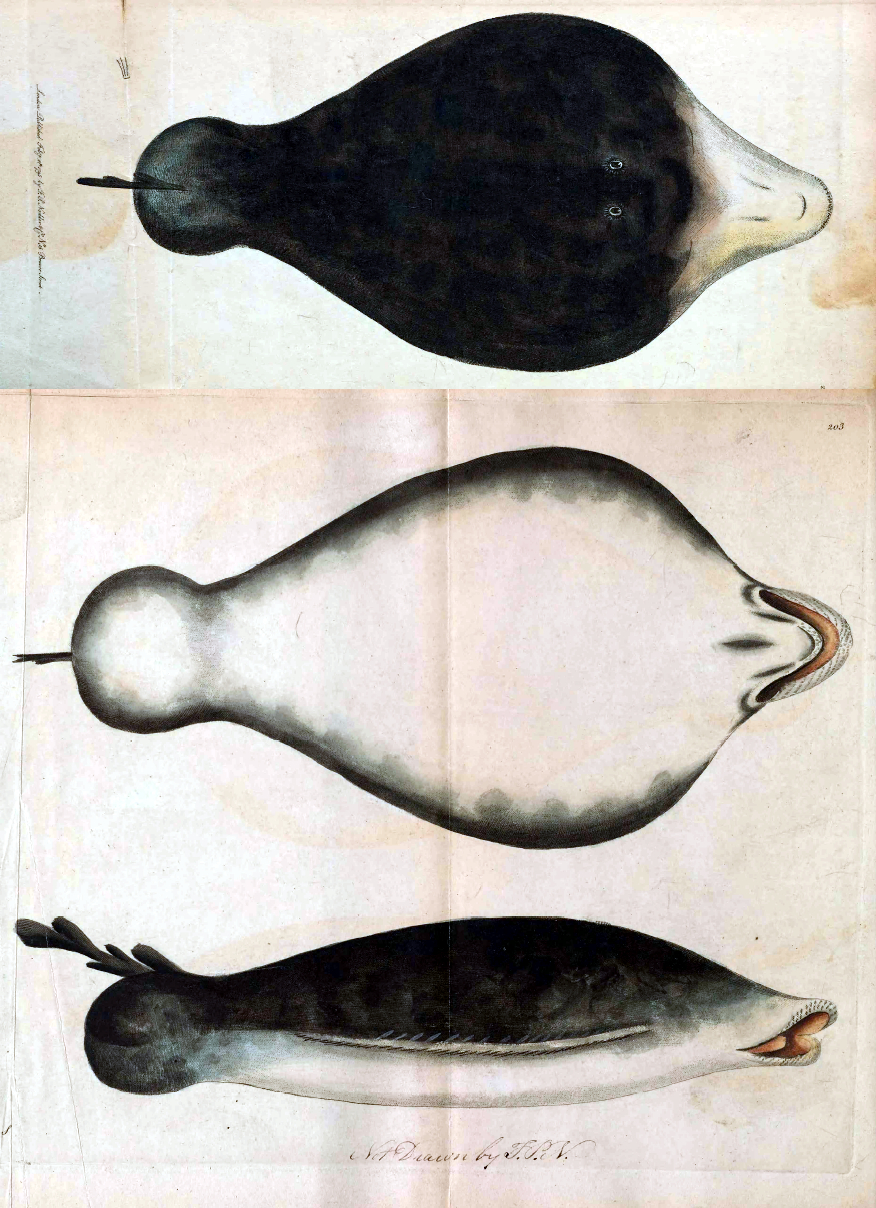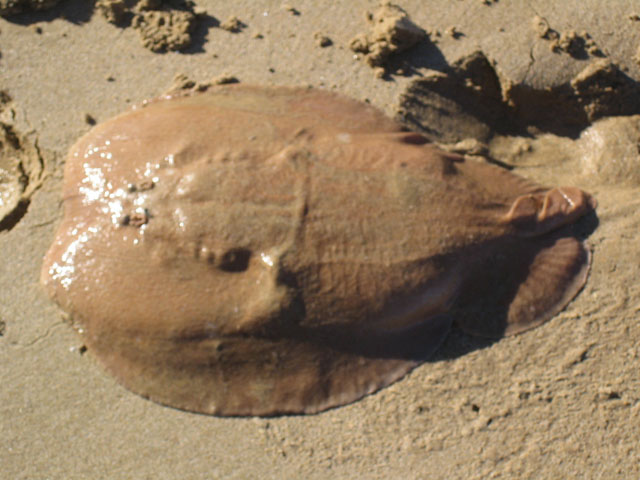Hypnos monopterygius
(Shaw, 1795)
Coffin ray
Classification: Elasmobranchii Torpediniformes Hypnidae
Reference of the original description
The Naturalist's Miscellany, or coloured figures of natural objects; drawn and described from nature. Vol. 6 London, Plate 202, 203 (published 1795 after Sherborn, C. D. 1895),
The Naturalist's Miscellany, or coloured figures of natural objects; drawn and described from nature. Vol. 6 London, Plate 202, 203 (published 1795 after Sherborn, C. D. 1895),
Image of the original description

Lophius monopterygius Shaw, 1795 valid as Hypnos monopterygius (Shaw, 1795); Original Plate

Lophius monopterygius Shaw, 1795 valid as Hypnos monopterygius (Shaw, 1795); Original Plate
Synonyms / new combinations and misspellings
Hypnarce monopterygium, Hypnarce subnigra, Hypnarce subnigrum, Hypnos monopterigium, Hypnos monopterygium, Hypnos subniger, Hypnos subnigrum, Lophius monopterygius
Hypnarce monopterygium, Hypnarce subnigra, Hypnarce subnigrum, Hypnos monopterigium, Hypnos monopterygium, Hypnos subniger, Hypnos subnigrum, Lophius monopterygius
Description :
Citation: Hypnos monopterygius (Shaw, 1795): In: Database of modern sharks, rays and chimaeras, www.shark-references.com, World Wide Web electronic publication, Version 01/2026
Please send your images of "Hypnos monopterygius" to info@shark-references.com

Hypnos monopterygius (Shaw, 1795), © www.fish-base.org

Hypnos monopterygius (Shaw, 1795), © www.fish-base.org
Common names
 Australian numbfish,
Australian numbfish,  Coffin ray,
Coffin ray,  Crampfish,
Crampfish,  Electric ray,
Electric ray,  Numbfish,
Numbfish,  Numbie,
Numbie,  Short-tail electric ray,
Short-tail electric ray,  Torpedo
Torpedo
 Australian numbfish,
Australian numbfish,  Coffin ray,
Coffin ray,  Crampfish,
Crampfish,  Electric ray,
Electric ray,  Numbfish,
Numbfish,  Numbie,
Numbie,  Short-tail electric ray,
Short-tail electric ray,  Torpedo
Torpedo
Short Description
A moderate-sized batoid with a greatly reduced short slender tail. Body entirely naked above and below, without dermal denticles or thorns. Trunk depressed and flattened, not shark-like. Precaudal tail slightly depressed, with weak lateral ridges on sides, tail abruptly narrower than trunk, no barbed sting (stinger or stinging spine) on dorsal surface of tail, no electric organs in tail. Head broad and depressed; snout moderately elongated, anteriorly nearly straight; snout supported by rostral cartilages consisting of a pair of elongated lateral plates articulating (not fused) with cranium, and by the anteriorly expanded antorbital cartilages; not formed into a rostral saw and without lateral saw teeth. Five small gill openings on underside of front half of pectoral-fin bases, not visible in lateral view; no gill sieves or rakers on internal gill slits. Eyes dorsolateral on head and anterior to spiracles, small but well-developed. Mouth broadly arched and broad, without prominent knobs and depressions and with labial furrows absent; a strong groove at distal ends of mouth but not around its periphery. Nostrils just anterior to mouth and separated from it by much less than their own widths, connected by broad nasoral grooves with mouth; anterior nasal flaps short and medially expanded and fused into a narrow nasal curtain that overlapsmouth. Oral teeth small, with flat bases and 3 prominent cusps, not laterally expanded and plate-like, similar in shape and in over 60 rows (adults) in either jaw. Pectoral fins large and forming a pear-shaped disc about as wide as long, originating at anterior edges of snout lateral to snout tip, attached to entire head and ending posterior to pelvic-fin origins; disc not subdivided at eyes. Large kidney-shaped electric organs at bases of pectoral fins, these visible through skin. Pelvic fins low, broadly rounded and not divided into anterior and posterior lobes. Two equal-sized small dorsal fins, each rounded-angular in shape with apices, anterior, posterior and inner margins, and free rear tips more or less confluent. First dorsal fin originates far behind anterior half of total length, origin and base over rear half of pelvic-fin bases and well anterior to midlength of tail. Caudal fin small, about as large as dorsal fins and much smaller than pelvic fins, not shark-like, nearly symmetrical and rounded, with vertebral axis hardly raised above body axis; lower caudal-fin lobe absent. Colour: uniform chocolate brown, reddish brown, grey, sandy or pinkish above, often with sparse irregular darker and lighter spots and blotches, spiracular papillae and disc margin lighter, underside yellowish, greyish white, or white [16824].
A moderate-sized batoid with a greatly reduced short slender tail. Body entirely naked above and below, without dermal denticles or thorns. Trunk depressed and flattened, not shark-like. Precaudal tail slightly depressed, with weak lateral ridges on sides, tail abruptly narrower than trunk, no barbed sting (stinger or stinging spine) on dorsal surface of tail, no electric organs in tail. Head broad and depressed; snout moderately elongated, anteriorly nearly straight; snout supported by rostral cartilages consisting of a pair of elongated lateral plates articulating (not fused) with cranium, and by the anteriorly expanded antorbital cartilages; not formed into a rostral saw and without lateral saw teeth. Five small gill openings on underside of front half of pectoral-fin bases, not visible in lateral view; no gill sieves or rakers on internal gill slits. Eyes dorsolateral on head and anterior to spiracles, small but well-developed. Mouth broadly arched and broad, without prominent knobs and depressions and with labial furrows absent; a strong groove at distal ends of mouth but not around its periphery. Nostrils just anterior to mouth and separated from it by much less than their own widths, connected by broad nasoral grooves with mouth; anterior nasal flaps short and medially expanded and fused into a narrow nasal curtain that overlapsmouth. Oral teeth small, with flat bases and 3 prominent cusps, not laterally expanded and plate-like, similar in shape and in over 60 rows (adults) in either jaw. Pectoral fins large and forming a pear-shaped disc about as wide as long, originating at anterior edges of snout lateral to snout tip, attached to entire head and ending posterior to pelvic-fin origins; disc not subdivided at eyes. Large kidney-shaped electric organs at bases of pectoral fins, these visible through skin. Pelvic fins low, broadly rounded and not divided into anterior and posterior lobes. Two equal-sized small dorsal fins, each rounded-angular in shape with apices, anterior, posterior and inner margins, and free rear tips more or less confluent. First dorsal fin originates far behind anterior half of total length, origin and base over rear half of pelvic-fin bases and well anterior to midlength of tail. Caudal fin small, about as large as dorsal fins and much smaller than pelvic fins, not shark-like, nearly symmetrical and rounded, with vertebral axis hardly raised above body axis; lower caudal-fin lobe absent. Colour: uniform chocolate brown, reddish brown, grey, sandy or pinkish above, often with sparse irregular darker and lighter spots and blotches, spiracular papillae and disc margin lighter, underside yellowish, greyish white, or white [16824].
Human uses
fisheries: of no interest
fisheries: of no interest
Biology
Exhibit ovoviparity (aplacental viviparity), with embryos feeding initially on yolk, then receiving additional nourishment from the mother by indirect absorption of uterine fluid enriched with mucus, fat or protein through specialised structures [733]. Size at birth 8 to 11 cm TL [16824].
Diet: [25399] data source: 82 specimens, 25 (30.5%) contained prey items, with teleost fishes (%IRI ¼ 51.2) and cephalopod molluscs (%IRI ¼ 48.1) comprising the most important prey categories Found on sand, mud, in grass beds, on coral and rocky reef sand patches, and reef flats. Depth ranges from the intertidal to zone to 240 m. Buries itself and sometimes found stranded out of water by the tide but is capable of surviving for hours [16824]. Feeds on crabs, worms, and fishes.
Exhibit ovoviparity (aplacental viviparity), with embryos feeding initially on yolk, then receiving additional nourishment from the mother by indirect absorption of uterine fluid enriched with mucus, fat or protein through specialised structures [733]. Size at birth 8 to 11 cm TL [16824].
Diet: [25399] data source: 82 specimens, 25 (30.5%) contained prey items, with teleost fishes (%IRI ¼ 51.2) and cephalopod molluscs (%IRI ¼ 48.1) comprising the most important prey categories Found on sand, mud, in grass beds, on coral and rocky reef sand patches, and reef flats. Depth ranges from the intertidal to zone to 240 m. Buries itself and sometimes found stranded out of water by the tide but is capable of surviving for hours [16824]. Feeds on crabs, worms, and fishes.
Dentition
Teeth were small and tricuspidate, with the central cusp approximately twice as long as the lateral cusps. In mature males, the three cusps were aligned parallel to one another, whereas in mature females, the lateral cusps curved away from the central cusp. Occlusal teeth had a pronounced posterior orientation. Tooth file and row number was independent of sex, but increased with body size. The smallest individual examined (total length (LT) ¼ 185 mm; body mass (Mb) ¼ 235 g) had 42 tooth files and 14 tooth rows on each jaw, and the largest individual (LT ¼ 595 mm, Mb ¼ 7.570 g) had 90 files and 21 row. [16824]
Teeth were small and tricuspidate, with the central cusp approximately twice as long as the lateral cusps. In mature males, the three cusps were aligned parallel to one another, whereas in mature females, the lateral cusps curved away from the central cusp. Occlusal teeth had a pronounced posterior orientation. Tooth file and row number was independent of sex, but increased with body size. The smallest individual examined (total length (LT) ¼ 185 mm; body mass (Mb) ¼ 235 g) had 42 tooth files and 14 tooth rows on each jaw, and the largest individual (LT ¼ 595 mm, Mb ¼ 7.570 g) had 90 files and 21 row. [16824]
Remarks
shark-references Species-ID=3102;
shark-references Species-ID=3102;
Parasites (arranged by Jürgen Pollerspöck)
Cestoda
Hirudinea
Cestoda
- Acanthobothrium angelae Campbell & Beveridge, 2002 [16128] [28741]
- Lacistorhynchus dollfusi Beveridge & Sakanari, 1987 [16253] [16112]
Hirudinea
- Branchellion plicobranchus Raj, 1953 [28595]

















